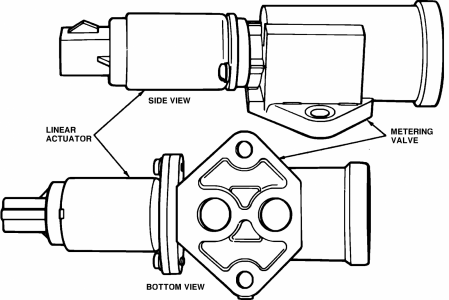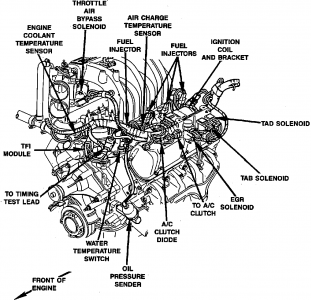You are using an out of date browser. It may not display this or other websites correctly.
You should upgrade or use an alternative browser.
You should upgrade or use an alternative browser.
351W starting 89 Bronco
- Thread starter captsb890
- Start date
Disclaimer: Links on this page pointing to Amazon, eBay and other sites may include affiliate code. If you click them and make a purchase, we may earn a small commission.
Motech
Well-known member
I love explaining this stuff, but it's late, so I'll paste Ford's published Description and Operation data:
IDLE AIR BYPASS VALVE or IDLE AIR CONTROL (IAC) VALVE or THROTTLE AIR BYPASS SOLENOID
The air bypass valve solenoid, Fig. 1, is used to control engine idle speed and is operated by the EEC-IV control module. This valve allows air to pass around the throttle plates to control, cold engine fast idle, no touch start, dashpot, over temperature idle boost and engine idle load correction.
It's part of the Air Sub-System
The air sub-system consists of an air cleaner, an air cleaner valve assembly, vane meter, throttle air bypass valve and air tubes.
Air entering the engine is measured by the vane meter located between the air cleaner and throttle body assembly.
The output of the vane meter is applied directly to the ECA to assist in determining the correct air/fuel ratio. The vane meter consists of two separate sensors, a vane airflow (VAF) sensor and a vane air temperature (VAT) sensor.
The throttle air bypass valve regulates the amount of air which flows around the throttle plate to control engine idle speed.
Adaptive strategy has been added to the EEC-IV system. This feature continually adjusts the calibration strategy to correct for wear and aging calibration components. The adaptive strategy then retains the adjustments in the keep alive memory (KAM) so they will not be lost (cancelled) when the ignition switch is turned OFF.
A short adjustment period will occur:
If an EEC component is replaced (due to age or damage), the memory may need to be cleared to eliminate the adaptive adjustments that were made to correct the replaced component.
It is possible for the engine operation to actually deteriorate because the new component will be controlled as if it were still the replaced aged or damaged component.
During the adjustment or learning period (usually under 5 miles of driving) some vehicles could exhibit abnormal drive symptoms (surge, hesitation and high idle speeds).
Hope this helps.
IDLE AIR BYPASS VALVE or IDLE AIR CONTROL (IAC) VALVE or THROTTLE AIR BYPASS SOLENOID
Fig. 1 Air bypass valve assembly
- LH Side Of Engine, On Throttle Body
- Applicable to: V8-302/5.0L & V8-351/5.8L Engines
The air bypass valve solenoid, Fig. 1, is used to control engine idle speed and is operated by the EEC-IV control module. This valve allows air to pass around the throttle plates to control, cold engine fast idle, no touch start, dashpot, over temperature idle boost and engine idle load correction.
It's part of the Air Sub-System
The air sub-system consists of an air cleaner, an air cleaner valve assembly, vane meter, throttle air bypass valve and air tubes.
Air entering the engine is measured by the vane meter located between the air cleaner and throttle body assembly.
The output of the vane meter is applied directly to the ECA to assist in determining the correct air/fuel ratio. The vane meter consists of two separate sensors, a vane airflow (VAF) sensor and a vane air temperature (VAT) sensor.
The throttle air bypass valve regulates the amount of air which flows around the throttle plate to control engine idle speed.
(Me) It literally regulates a vacuum leak to control idle speed. Bigger leak, higher RPM.
ADAPTIVE STRATEGYAdaptive strategy has been added to the EEC-IV system. This feature continually adjusts the calibration strategy to correct for wear and aging calibration components. The adaptive strategy then retains the adjustments in the keep alive memory (KAM) so they will not be lost (cancelled) when the ignition switch is turned OFF.
A short adjustment period will occur:
- on new vehicles
- when the battery has been disconnected during normal service (erases KAM)
- when the electronic control assembly (ECA) is disconnected or replaced (erases KAM)
- when a component of the EEC-IV system is replaced
If an EEC component is replaced (due to age or damage), the memory may need to be cleared to eliminate the adaptive adjustments that were made to correct the replaced component.
It is possible for the engine operation to actually deteriorate because the new component will be controlled as if it were still the replaced aged or damaged component.
During the adjustment or learning period (usually under 5 miles of driving) some vehicles could exhibit abnormal drive symptoms (surge, hesitation and high idle speeds).
Hope this helps.
Similar threads
- Replies
- 169
- Views
- 9K
- Replies
- 1
- Views
- 421


